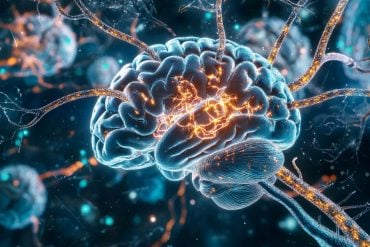Summary: A new study reports children who are subjected violence early in life experience faster biological aging, including earlier onset of puberty and epigenetic aging, than peers who are not abused. Additionally, children exposed to other early life adversities, such as poverty and food insecurity, show delayed signs of pubertal development.
Source: Elsevier.
A study in Biological Psychiatry has shown that exposure to violence early in life – such as physical, emotional, or sexual abuse – is associated with faster biological aging, including pubertal development and a cellular metric of biological aging called epigenetic age. In contrast, children exposed to forms of early life adversity involving deprivation – such as neglect and food insecurity – showed signs of delayed pubertal development compared with their peers.
“[The findings] demonstrate that different types of early-life adversity can have different consequences for children’s development,” said senior author Katie McLaughlin, PhD, who completed the study at University of Washington. Poor physical and mental health outcomes associated with early life adversity have been attributed to accelerated development. However, the new findings show that violence- and deprivation-related adversity have different effects on development, indicating that the specific type of adversity should be considered to better understand how an experience will affect a child later in life.
In children who experienced early life violence, accelerated epigenetic aging was associated with increased symptoms of depression. According to the authors, this means that faster biological aging may be one way that early life adversity “gets under the skin” to contribute to later health problems.

The 247 children and adolescents involved in the study were 8-16 years old. “These findings indicate that accelerated aging following exposure to violence early in life can already be detected in children as young as 8 years old,” said Dr. McLaughlin.
“With each new study, it seems that our appreciation grows of the enormous and persisting impact of early life exposure to violence. This new knowledge calls for increased societal investment in reducing the exposure of children to violence and for biomedical and psychological research to reduce the impact of these experiences throughout the lives of these vulnerable individuals,” said John Krystal, MD, Editor of Biological Psychiatry.
Although researchers don’t know if accelerated epigenetic aging is permanent or if it can be reversed, the association between the aging metrics and symptoms of depression in this study may offer a way for doctors to identify children who need help. “Accelerated epigenetic age and pubertal stage could be used to identify youth who are developing faster than expected given their chronological age and who might benefit from intervention. Pubertal stage is an especially useful marker because it is easy and inexpensive to assess by healthcare providers, and could be used to identify youth who may need more intensive health services,” said Dr. McLaughlin.
Source: Rhiannon Bugno – Elsevier
Publisher: Organized by NeuroscienceNews.com.
Image Source: NeuroscienceNews.com image is in the public domain.
Original Research: Abstract for “Early Experiences of Threat, but Not Deprivation, Are Associated With Accelerated Biological Aging in Children and Adolescents” by Jennifer A. Sumner, Natalie L. Colich, Monica Uddin, Don Armstrong, Katie A. McLaughlin in Biological Psychiatry. Published September 26 2018.
doi:10.1016/j.biopsych.2018.09.008
[cbtabs][cbtab title=”MLA”]Elsevier”Children Who Experience Violence Early in Life Develop Faster.” NeuroscienceNews. NeuroscienceNews, 1 November 2018.
<https://neurosciencenews.com/abuse-puberty-10130/>.[/cbtab][cbtab title=”APA”]Elsevier(2018, November 1). Children Who Experience Violence Early in Life Develop Faster. NeuroscienceNews. Retrieved November 1, 2018 from https://neurosciencenews.com/abuse-puberty-10130/[/cbtab][cbtab title=”Chicago”]Elsevier”Children Who Experience Violence Early in Life Develop Faster.” https://neurosciencenews.com/abuse-puberty-10130/ (accessed November 1, 2018).[/cbtab][/cbtabs]
Abstract
Early Experiences of Threat, but Not Deprivation, Are Associated With Accelerated Biological Aging in Children and Adolescents
Background
Recent conceptual models argue that early life adversity (ELA) accelerates development, which may contribute to poor mental and physical health outcomes. Evidence for accelerated development in youths comes from studies of telomere shortening or advanced pubertal development following circumscribed ELA experiences and neuroimaging studies of circuits involved in emotional processing. It is unclear whether all ELA is associated with accelerated development across global metrics of biological aging or whether this pattern emerges following specific adversity types.
Methods
In 247 children and adolescents 8 to 16 years of age with wide variability in ELA exposure, we evaluated the hypothesis that early environments characterized by threat, but not deprivation, would be associated with accelerated development across two global biological aging metrics: DNA methylation (DNAm) age and pubertal stage relative to chronological age. We also examined whether accelerated development explained associations of ELA with depressive symptoms and externalizing problems.
Results
Exposure to threat-related ELA (e.g., violence) was associated with accelerated DNAm age and advanced pubertal stage, but exposure to deprivation (e.g., neglect, food insecurity) was not. In models including both ELA types, threat-related ELA was uniquely associated with accelerated DNAm age (β = .18) and advanced pubertal stage (β = .28), whereas deprivation was uniquely associated with delayed pubertal stage (β = −.21). Older DNAm age was related to greater depressive symptoms, and a significant indirect effect of threat exposure on depressive symptoms was observed through DNAm age.
Conclusions
Early threat-related experiences are particularly associated with accelerated biological aging in youths, which may be a mechanism linking ELA with depressive symptoms.






